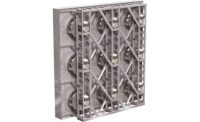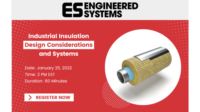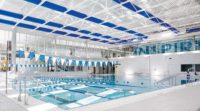When it comes to the plenum area, “out of sight” must never become “out of mind.” Whether located under an elevated floor, such as in a data center, or above the dropdown ceiling of a conference room, plenum areas are home to cables, combustible materials, and connections that present concerns when it comes to specifying materials used to insulate and protect the pipes, cables, and connections in this oft-overlooked region of the enclosure.
Regardless of a building’s function, plenums typically provide space for the mechanical pipes, cables, and wires connecting voice and data systems, HVAC equipment, IT networks, and various communications systems throughout a building. A special concern from a life safety perspective is that plenums are home to combustible materials as well as various pipes, cables, and wires that may yield toxic fumes and smoke. The air exchange occurring in the plenum space can also help a fire propagate, in turn threatening valuable egress time. The combination of combustible materials and airflow presents considerations when it comes to the materials wrapping pipes in the plenum.
The nature of the plenum space presents challenges that include safety, sealing — a material’s tendency to stay sealed and secured once installed — and sound considerations. While all these attributes are important, safety will always be priority one. Below, we look at how a fire in a plenum area more than 40 years ago inspired changes to support life safety. We also consider how changes in the mechanical code relate to the insulation specified for plastic pipes in plenum areas.
A historic plenum fire inspires changes
Nearly four decades before the tragic events of 9/11, another New York City fire ignited in the north tower of the World Trade Center. The February 1975 fire set precedent for the development of codes and testing methods in the plenum area.
Following the blaze, the New York Board of Fire Underwriters Bureau of Fire Prevention and Public Relations issued a report calling attention to materials housed in the tower’s plenum. Among conditions documented in the report, it was noted that exposed polyethylene and polyvinyl chloride cable insulation and plastic back panel blocks burned so readily that all combustible materials, including fire-retardant paneling, were destroyed. According to published reports, high temperatures in the plenum radiated enough heat to melt the plastic on phones and char desktop papers. The report noted: “Cables passing from one closet to another closet on the same floor pass through the plenum above the hung ceiling. The exposed cable is combustible and constitutes a hazard, because fire will be drawn into the plenum and the insulation will intensify the fire at this point.”
An evolution in fire safety spurs code changes
This report was just one factor helping to spur an evolution in fire safety practices in plenum spaces. It helped inform listing agencies, such as Underwriters Laboratories (UL), to develop reproducible tests based on standards to assess safety in the plenum space. Consequently, today’s codes have evolved, and there have been multiple changes to the International Building Code and International Mechanical Code. Because plenums are often the site of piping networks connecting various mechanical or sprinkler systems — and comprised of PVC and other combustible materials — mechanical systems housed in this area demand special attention.*
The International Mechanical Code and non-combustibles in the plenum space Section 602.2.1 of the 2012, 2015, and 2018 International Mechanical Code applies to plenum materials, including mechanical pipes, and specifies that materials shall be noncombustible. The Mechanical Code also specifies that materials shall be listed and labeled with a flame spread index not more than 25 and a smoke developed index not more than 50 when tested in accordance with ASTM E84 or UL 723. There is an exception. Exception No. 5 applies to combustibles fully enclosed within one of the following: 5.3 Material listed and labeled for installation within a plenum.
ASTM E84 Standard Test Method for Surface Burning of Building Materials or UL 723 Standard for Test for Surface Burning Characteristics of Building Materials serve as “reaction to fire” test standards. These tests assess the flame spread and measure the amount of smoke that is produced by the materials used, not hourly fire resistance.
ASTM E 119 Standard Test Methods for Fire Tests of Building Construction and Materials or UL 263 Standard Fire Tests of Building Construction and Materials are the test standards that provide fire-resistance ratings and determine hourly fire-resistance ratings for building assemblies. These test methods are completely different from the ASTM E84 and UL 723 test methods. Both ASTM E119 and UL 263 measure hourly fire resistance, whereas ASTM E84 and UL 723 measure reaction to fire.
Any installed materials, including insulation or plenum wrap, should comply fully with a listing organization, such as UL, and its requirements for covering materials on the insulated plastic pipe assembly as mandated by the building code, at a minimum.
When specifying materials in the plenum area, life safety will always be the priority. However, other considerations can also influence material choice. Specifiers should consider material attributes, such as a material’s ease of installation and handling on the job site, and the maintenance it requires once installed. Because plenum areas can be challenging to access and difficult to move about in, the insulation covering pipes should be lightweight and sized at the appropriate width for easy handling. It is also important that secure sealing mechanisms are in place to keep the insulation jacketing firmly in place.
Consider ancillary attributes – sealing and sound
The insulation installed in neighboring areas of the plenum space — for example, wall assemblies — should complement the purpose of the building and the occupants served. Institutional spaces, such as hospitals, may house non-ambulatory or very young/old occupants who would be unable to evacuate a building of their own accord in the event of fire. High-rise buildings are another type of structure that presents challenges for egress. The noncombustible nature of mineral wool insulation installed in the assemblies of such structures makes it a good material to support life safety.
While building codes represent the critical compliance standards, other material attributes can come into play. The market’s appreciation for a material’s hygienic attributes, such as its ability to be wiped down, was evident during the pandemic. A polymer jacketing surface can be easily wiped down, not only maintaining the material’s clean and pristine appearance, but complementing hygiene efforts throughout the facility.
Finally, acoustics can be a sound consideration when it comes to insulating the plenum. These areas are often situated above drop ceilings, creating conditions where noise can flow unobstructed into other parts of the building. Any hotel guest or patient who has spent the night in a room above water pipes or adjacent to mechanical systems will appreciate how institutional noise and rest are opposing conditions. Once again, installing mineral wool in assemblies adjacent to plenum areas housing pipes can help manage flanking noise and keep unwanted sounds to a minimum.
While often unseen, plenum spaces are essential to the processing of functions throughout the building. Considering the nature of the plenum space and the areas adjacent to it, as well as a material’s handling profile, can help specifiers achieve compliance and desired performance objectives.





